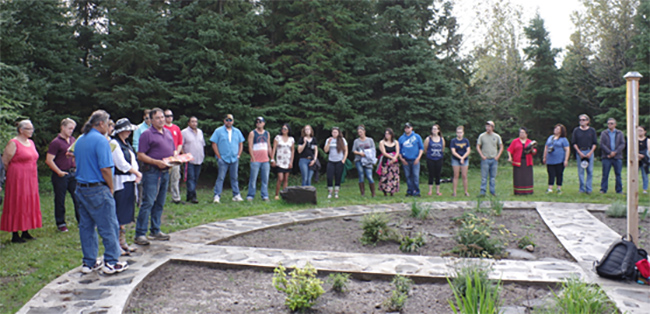Medicine Wheel garden at Lakehead University to unite nations from all over the world

By Rick Garrick
THUNDER BAY – Fort William Chief Peter Collins helped open up Lakehead University’s new medicine wheel garden, which contains rock he delivered from Fort William, on Sept. 23.
“Fort William is excited about being a participant in the medicine wheel (garden),” Collins says. “I think it is a very inspiring moment for the university and also Fort William in partnership.”
Collins laid the first rock when the garden was being constructed this past summer at the university’s Sweat Lodge Site just west of the C.J. Sanders Fieldhouse.
“It was good — I was excited about being part of the build,” Collins says. “I saw the guys that were working there, the hard work and the determination that they had to develop the medicine wheel.”
Tannis Kastern, a fourth-year Indigenous Learning student and Lakehead University Student Union Board of Directors member from Fort William, says the purpose of the garden is to unite nations from all over the world. Lakehead University welcomed a record number of international students this year, with more than 400 enrolled for the 2017-2018 academic year.
“You come from everywhere (and) you’re here on our territories and it’s an honour to have your presence,” Kastern says about the international students. “If you ever need to come and take a break, that is what this place is for. You don’t have to be Indigenous to come and utilize this space.”
Kastern enjoyed watching the garden project come together over the summer, noting that she is friends with all of the construction crew.
“They had a vision and look at the result,” Kastern says. “I’m hoping all the university students utilize this space and come and read a book or just take their minds off everything because sometimes it’s not so easy being in school.”
Keith Fenton, a Native Access Program student from Animakee Wa Zhing, says the garden project was “very physical.”
“But with the right guys, it was always fun,” Fenton says. “Altogether, there was probably a dozen of us that were (working) in different capacities.”
Fenton says the groundwork and lining up the directions for the medicine wheel were the key points of the project.
“And making sure, coordinating it, that it was a complete circle,” Fenton says.
Peggy Smith, Lakehead University’s interim vice-provost (Aboriginal Initiatives), says the garden includes a variety of medicine plants that are arranged by colour, including yarrow, echinacea, sage, sweetgrass, irises, arctic willow and juniper.
“The yellows go in the east quadrant, the blues and the purples go in the south, the reds and the magentas go in the west and the greys and the whites go into the north quadrant,” Smith says. “It will be a process to learn more about the medicines, so over time hopefully this can become a teaching garden so we can learn more about how to use those medicines.”
Smith says one of the delegates from the 6th Canada Mexico Roundtable gathering held this summer at Lakehead University was so impressed that she wanted to build a similar garden back home in Mexico.
“We also have all kinds of people who walk through this area from around the neighbourhoods … who have commented on what a beautiful spot it is,” Smith says. “My favourite time is to come in the morning as the sun is just coming up over the trees here. It’s quiet, peaceful, and I just take the opportunity to start the day by taking a walk around the wheel.”


